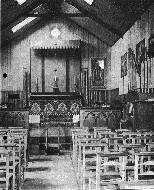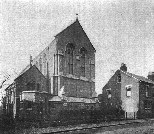History
The most recent history of All Saints Church can be found on our Facebook site, but history going back beyond the most recent decades is below split across several pages.
St. Aidans 1861 - 1909
A word about one aspect of Church history of the time may be helpful at this point, as it is not possible to understand the development of the Small Heath Churches without knowing something of the renewal of the catholic tradition in the Church of England.
Often dated from the 'Great Assize' sermon by John Keble at Oxford in July 1833, and associated with names such as Newman, Pusey, Liddon and others, the 'Oxford Movement', or 'Tractarians' sought to re establish within the Church of England an acceptance that it was, as it had always been, the true catholic faith of the land since the coming of Augustine and Aidan. A great effort of scholarship and missionary zeal was devoted to establishing the continuity of doctrine and practice of a variety of what had come to be considered by many as 'Romish' or 'Ritualistic' ways of worship - at best distasteful, at worst illegal.
There was much controversy, including court cases and imprisonings. But the catholic movement rooted itself firmly in the worst urban areas of the country - the east end of London, the north west of the country and here in the east side of Birmingham in the parishes of Holy Trinity, Saltley (St Saviour), Sparkhill (St Agatha), Highgate (St Alban), Small Heath (St Aidan, St Oswald, St Gregory and St Benedict) and many others besides - the 'biretta belt' as it became known later on. They rooted themselves in these areas because of their theology of Incarnation - that God became human in the person of Jesus and lived in the midst of his world.
The Church was to live out the incarnation in the worst places, bringing light, beauty and truth and humanity into drab places and lives. That was and is the guiding idea of the catholic tradition in the Church of England.
It resulted first in a missionary drive to live 'in the midst', and subsequently in the building of churches which were to be places where in the architecture, decorations and liturgy, the drama of God, was to be played out to its best effect.
The founder and first priest of St Aidan was the Revd James Agar Ellis, represented in the west window of this present building, holding a model of St Aidan's church.

A small mission church was quickly built in the garden and a photograph of it survives to this day. Loasby, who was for many years a churchwarden, describes it in his 1921 book as:
'a simple oblong building with no ornament except a few bold prints...the altar was large and well lighted, with quiet coloured hangings, a small uncased
organ stood out from the wall near the chancel step, and the long narrow mission church, which could accommodate about 200 people, was bright, airy and very peaceful'.
The building was located on the site of the present All Saints Church.
Because of the Church's love for the people and its desire to serve their whole needs, spiritual and physical, the congregation grew rapidly and by July 1893 it was resolved to begin the building of a permanent church. Loasby, who was amongst the first members, describes their feelings: 'the time had come to leave the dear little place where many had so learned the truth of God's love that all the changes and chances of many years of varied life have not dimmed the joy which those truths bestowed. Though the Mission of so many happy associations could not be left without some regrets, hope was high as we saw the new church growing course by course to its great height, until the first portion of a permanent church of quiet colour and noble proportion was completed to God's glory.... an answer to innumerable prayers'.

St Aidan's church was built on virtually the last remaining space in Herbert Road, in a garden left in the midst of the surrounding houses and to a considerable extent at the hands of parishioners themselves. The church building was, as it were, slotted into the remaining space, and it is this no doubt that accounts for it not being aligned east to west, but 30 degrees off to the north. The first portion of the church - chancel, guild chapel and to bays of the nave - was completed in 1894 and dedicated in October 1896.

It was not long however, before the congregation had grown to such an extent that it was decided to extend the building further to the west end. This was largely completed by Christmas 1898 and included the bell tower ('in the desert a voice cries aloud') and the baptistery. It is interesting to note that the beautiful apsidal west end was actually the third stage in the physical development of the building, each stage corresponding to the growth in the congregation.
Thomas Frederick Proud, whose memory (together with that of his wife Amy Meinart) is retained in the church in the dedication of the High altar and Lady chapel reredoses, was the chosen architect. He died in January 1901, not very long therefore after the church was completed.
Some decorative features of significance were placed in the building at this time, notably in 1907, the Good Shepherd window in the Guild Chapel by Bentram Lamplugh of The Birmingham School of Art.
Canon Newell Long succeeded Fr Agar Ellis at the end of 1901 and the development of the Church's buildings continued as need arose, and in 1904 a new clergy house was built alongside the church, after the demolition of the original house. The clergy house was designed as the home for a number of single male assistant curates under the care of a housekeeper. Already by the turn of the century, Fr Agar Ellis had been joined by Fr Day and Fr Long, subsequently to become the second vicar (curate in charge) and others were added to the staff.
The architect of the house was Arthur Dixon. He is of course better known in the works of reference than Thomas Proud, being a significant figure of the early phase of the Arts and Crafts movement in Birmingham. To his name are for example, St Basil's church, Deritend, St Andrew's church at Barnt Green and Tennal Grange at Harborne as well as 45 Great Charles Street for the Birmingham Guild of Handicraft.